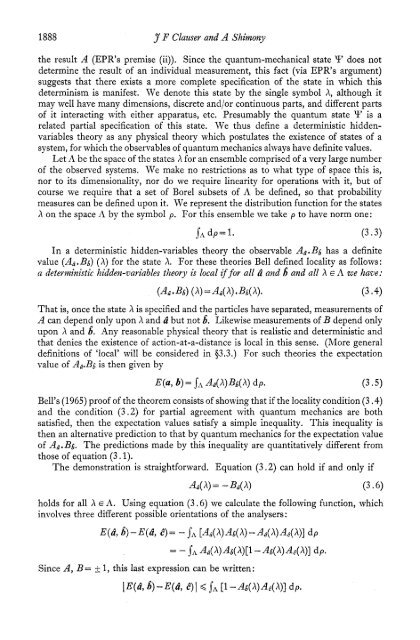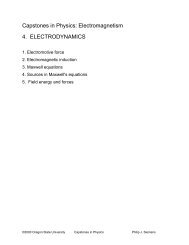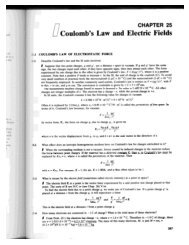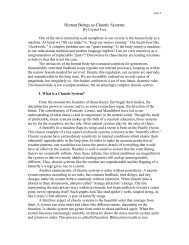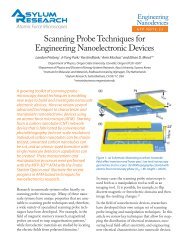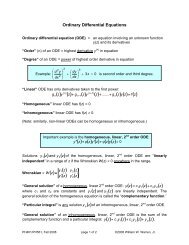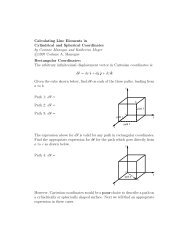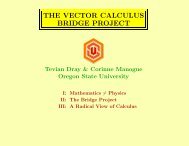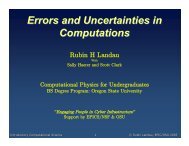Bell's theorem : experimental tests and implications - Physics at ...
Bell's theorem : experimental tests and implications - Physics at ...
Bell's theorem : experimental tests and implications - Physics at ...
Create successful ePaper yourself
Turn your PDF publications into a flip-book with our unique Google optimized e-Paper software.
1888 F Clausw <strong>and</strong> A Shimonythe result A (EPR’s premise (ii)). Since the quantum-mechanical st<strong>at</strong>e Y does notdetermine the result of an individual measurement, this fact (via EPRs argument)suggests th<strong>at</strong> there exists a more complete specific<strong>at</strong>ion of the st<strong>at</strong>e in which thisdeterminism is manifest. We denote this st<strong>at</strong>e by the single symbol A, although itmay well have many dimensions, discrete <strong>and</strong>/or continuous parts, <strong>and</strong> different partsof it interacting with either appar<strong>at</strong>us, etc. Presumably the quantum st<strong>at</strong>e Y is arel<strong>at</strong>ed partial specific<strong>at</strong>ion of this st<strong>at</strong>e. We thus define a deterministic hiddenvariablestheory as any physical theory which postul<strong>at</strong>es the existence of st<strong>at</strong>es of asystem, for which the observables of quantum mechanics always have definite values.Let A be the space of the st<strong>at</strong>es X for an ensemble comprised of a very large numberof the observed systems. We make no restrictions as to wh<strong>at</strong> type of space this is,nor to its dimensionality, nor do we require linearity for oper<strong>at</strong>ions with it, but ofcourse we require th<strong>at</strong> a set of Bore1 subsets of A be defined, so th<strong>at</strong> probabilitymeasures can be defined upon it. We represent the distribution function for the st<strong>at</strong>esA on the space A by the symbol p. For this ensemble we take p to have norm one:JA dp= 1. (3.3)In a deterministic hidden-variables theory the observable Ai. B6 has a definitevalue (Ad. Ba) (A) for the st<strong>at</strong>e A. For these theories Bell defined locality as follows:a deterministic hidden-variables theory is local if for all d <strong>and</strong> 6 <strong>and</strong> all A E A we have:(AL.Ba) (A)=A,(X).Bs(X). (3 *4)Th<strong>at</strong> is, once the st<strong>at</strong>e X is specified <strong>and</strong> the particles have separ<strong>at</strong>ed, measurements ofA can depend only upon X <strong>and</strong> d but not 6. Likewise measurements of B depend onlyupon h <strong>and</strong> 6, Any reasonable physical theory th<strong>at</strong> is realistic <strong>and</strong> deterministic <strong>and</strong>th<strong>at</strong> denies the existence of action-<strong>at</strong>-a-distance is local in this sense. (More generaldefinitions of ‘local’ will be considered in 93.3.) For such theories the expect<strong>at</strong>ionvalue of Ai.Ba is then given byE(a, b)= JA Aa(A)Bs(X) dp. (3.5)Bell’s (1965) proof of the <strong>theorem</strong> consists of showing th<strong>at</strong> if the locality condition (3.4)<strong>and</strong> the condition (3.2) for partial agreement with quantum mechanics are boths<strong>at</strong>isfied, then the expect<strong>at</strong>ion values s<strong>at</strong>isfy a simple inequality. This inequality isthen an altern<strong>at</strong>ive prediction to th<strong>at</strong> by quantum mechanics for the expect<strong>at</strong>ion valueof A,.Bs. The predictions made by this inequality are quantit<strong>at</strong>ively different fromthose of equ<strong>at</strong>ion (3.1).The demonstr<strong>at</strong>ion is straightforward. Equ<strong>at</strong>ion (3.2) can hold if <strong>and</strong> only ifAd( A) = - Bi( A) (3.6)holds for all h E A. Using equ<strong>at</strong>ion (3.6) we calcul<strong>at</strong>e the following function, whichinvolves three different possible orient<strong>at</strong>ions of the analysers :E(d, &)-E(d, e)= - JA [A;(h)As(h)-A,(X)A,(X)] dp= - JA Aa(h)As(h)[l -&(h)&(A)]dp.Since A, B = F 1, this last expression can be written :


